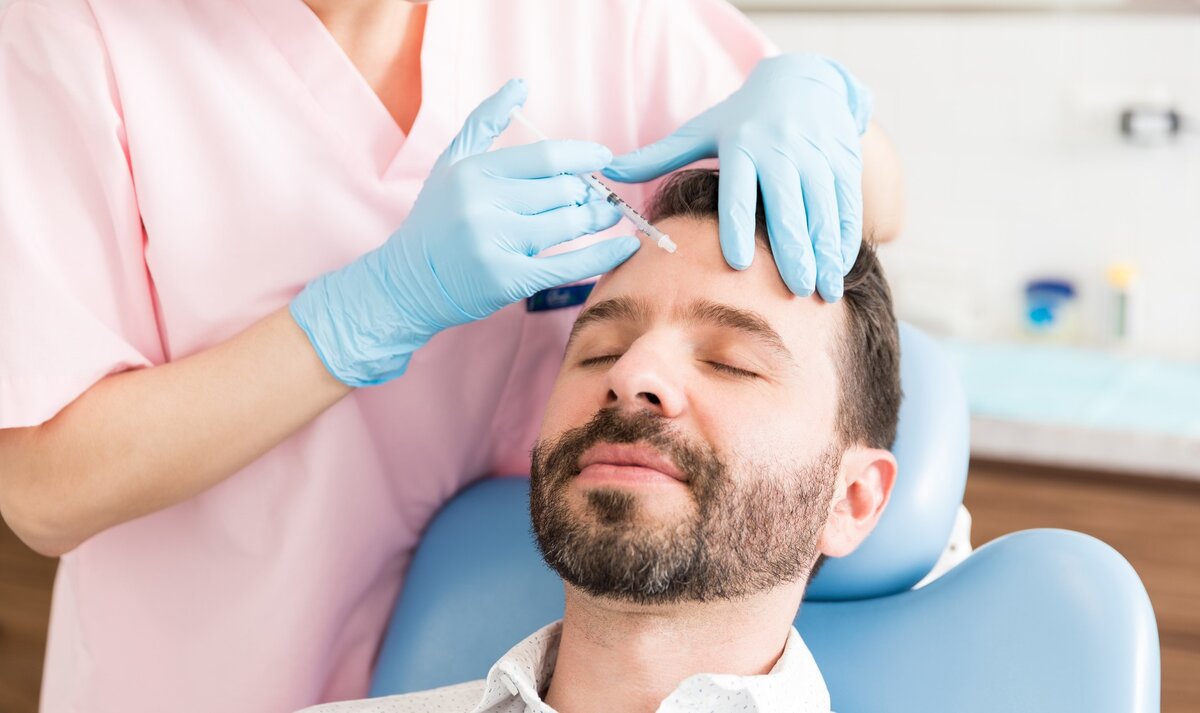 Migraine headaches are some of the most painful and debilitating conditions a person can experience. They can cause changes in brain activity as well as damage to nerve fibers. As migraine sufferers can attest, migraines are more than a headache. They can steal hours and even days from those who have them. While medications for this condition exist, they aren’t always effective, and some have many side effects.
Migraine headaches are some of the most painful and debilitating conditions a person can experience. They can cause changes in brain activity as well as damage to nerve fibers. As migraine sufferers can attest, migraines are more than a headache. They can steal hours and even days from those who have them. While medications for this condition exist, they aren’t always effective, and some have many side effects.
Some are surprised to learn that Botox, commonly known for cosmetic enhancements, is also an FDA-approved treatment for migraines. It can reduce the frequency and intensity of migraine pains. This post explores the connection between Botox and migraines and just exactly how Botox helps with pain relief from these chronic headaches.
Who Suffers from Migraines?
While anyone from any demographic can struggle with migraines, there are a few people who are at higher risk.
People with a family history of migraines
If your parents or siblings have migraines, you are at a greater risk of developing them too. The genetic link of migraines isn’t clear, but family history is a factor.
People of a certain age
Though these headaches can start at any age, they tend to begin in adolescence, peaking in the 30s. Fortunately, they can become less severe with age.
Sex of person
Again, while anyone can get a migraine, those born female are three times likelier to have migraines.
Another important factor is hormonal changes. Women who have migraines can find they are most severe nearing menstruation, pregnancy or menopause.
1. What is a Migraine, and How Does it Affect the Body?

Very often, migraines are a result of changes in brain activity that can cause wave-like disturbances. This is known as an aura, and it’s usually the first sign before feeling pain from a migraine. The pain will be felt on one side or both sides of the head, and most people experience nausea, vomiting, difficulty speaking or concentrating, sensitivity to light and sound, a feeling of the world spinning, or bright flashing lights.
Migraines can also be caused by irritation in the trigeminal nerve, which is the longest cranial nerve. This can be caused by injury or a brain tumor and may also cause pain on one side or both sides of the head. Because migraines can cause changes in brain activity, they have been shown to be a risk factor for other neurological conditions.
Migraines are also a common trigger for many other conditions, including hypertension, depression and anxiety disorders, and sleep apnea. It is always recommended to share your migraine symptoms with your healthcare professional to help determine the cause and unique effects it can be having on your body.
2. What is Botox?
Botox is a common cosmetic procedure that has been around for decades. It’s designed to reduce the appearance of wrinkles and fine lines by blocking certain nerve endings in the face. It has long been used by Hollywood celebrities who want to maintain their youthful appearance, but it can also be used by anyone looking to improve their looks. The process involves injecting small amounts of the botulinum toxin into specific muscles in order to stop them from moving. This reduces wrinkles on the forehead and around the eyes because those muscles won’t contract at all when they’re injected with Botox. This procedure is typically done on an outpatient basis, meaning that you can go home after the treatment and resume your normal activities.
Botox injections can also be used to treat common physical conditions such as chronic migraines, excessive sweating, and muscle spasms. It is important to note that Botox injections are not typically meant as a cure for these issues, but rather they can provide temporary relief for certain symptoms.
3. Can Botox Help with Migraines?
Botox is FDA-approved to help prevent migraine attacks. It may not stop them from happening, but it can provide relief for people that experience these headaches on a regular basis. It is injected in small doses that are gradually increased over time. Botox can help stop migraines because it reduces the severity of muscle contractions and chemical reactions in your body.
It’s important to note that Botox does not work on everyone, but many people have reported a reduction or complete elimination of their migraine pain when using Botox injections as part of their treatment plan.
4. What is the Success Rate of Botox for Migraines?
Because Botox has been getting more popular as an injection that can prevent or reduce the frequency of migraines by blocking contradictions in muscles in your head or neck, it’s important to understand the success of others who have already gone through the process. As you can imagine, the success rate for Botox is different for each person and varies depending on a number of factors.
It is important that Botox injections are administered by physicians who have experience performing them, as well as the knowledge and training needed to treat migraines successfully. One study found that Botox has been shown to be successful for up to 65% of people who suffer from migraines after three courses of treatment.
Researchers noted that no patients exhibited resistance to the treatment, and it was safe without any severe side effects. The safety analysis showed that there were no serious adverse events. However, a few patients experienced mild adverse reactions in the injection site and body pain around the neck and shoulder area.
5. Where Do They Inject Botox for Migraine Headaches?

The injection part of this therapy option means needles will be involved in order to administer the product inside as well as anesthetic cream or lotion for numbing purposes. Botox injections are injected into nerves in your head or neck as well as around the botulinum toxin injection site to help reduce muscle contractions.
For migraine headaches, Botox is usually administered through a series of small doses that gradually increase over time and can be up to 20 times more potent than regular Botox. The dose range is typically between 12 and 15 units per session.
Botox is usually injected on one side of the head at a time because Botox works best when administered to muscles that primarily affect only one side of the body. Treatment for migraines will be different from treatment for other conditions such as TMJ or wrinkles.
6. Does Botox for Migraines Have Side Effects?
A botulinum toxin injection is very safe and has few side effects. The most common side effect reported by patients was muscle soreness at the injection site, which typically goes away within a week of treatment.
This botulinum toxin injection is also known to produce a “wearing-off effect” or lessening of the Botox effects over time. This starts as early as two weeks after treatment and may last for months, but it usually comes back in full force when you get your next Botox treatment session.
It is possible to experience:
- Redness – Redness and swelling at the injection site is a common side effect, but it usually goes away within a few hours.
- Headaches or neck pain – Temporary headache or neck ache due to nerve blockage from needles used for injections may occur. While it is temporary, this can last up to a day. Usually, the more you get injected in any given area, the more prominent these side effects will be.
- Numbness – This is both a side effect and a bonus. Temporary numbness in the treated area from anesthetic cream or lotion used for needles during injection therapy prevents discomfort from the injection itself. This usually goes away within a few hours.
- Jawline numbness – Some people experience a numb chin after injections around the jawline. While it is temporary, it can last a bit longer than other side effects. It usually takes about three days for this numbness to completely subside.
- Bruising – Temporary bruising in the treated area is quite common but depends on the person’s own body chemistry. These slight bluish tints go away after a day or so.
Not everyone will experience all these side effects, and some may not have any side effects at all. There are some rare Botox side effects that may be experienced by some people, but they are not too serious. These include headaches and drooping eyelids, as Botox can affect the nerves in your head or neck and cause weakness of muscles around these areas. Some people could also experience allergic reactions to Botox, but this is rare.
After your injection, it’s suggested you avoid rubbing the area of injection, vigorous forms of exercise, and any other services you would typically get for this area, such as a facial. Taking some medications could also be a cause for concern, so to set yourself up for success, it’s important to discuss Botox use and its potential side effects with your doctor before beginning treatment.
7. How Long Does Botox Take to Work for Migraines?
As with any treatment, how long it takes varies widely. For most people, Botox can take up to two weeks to start working. The effects will be gradual and work best when administered over time rather than in one large dose. Some people have reported improvement in their migraines after Botox treatment within the first few days, but this is not typical.
You may also notice some benefits in the first few days, such as fewer or less severe headaches. However, these improvements are temporary, and you will need ongoing treatments to maintain your results.
If Botox doesn’t seem to be working for your migraine attacks, it’s important to find out why and talk with a medical professional about other treatments that can help you get relief from migraines. Consider Botox one option for combatting these debilitating headaches.
Find Botox Injections for Your Migraines

As you can see, Botox injections for migraines are a safe and successful option that has been shown to work in up to 65% of patients after three sessions. Botox also typically takes around two weeks before you start noticing any changes, but it’s important to be patient while Botox is working its way into your system. The most common side effect is muscle soreness or pain at the botulinum toxin injection site.
There are other more rare Botox side effects too, but they can be managed by discussing them with your doctor before beginning treatment and adjusting how you take certain medications for Botox use. Botox will not work for everyone, which means it’s important to find out why Botox isn’t working for you and what other treatments could help. A botulinum toxin injection is very safe, so it’s worth the trial if Botox can provide relief from your migraines to relieve pain and suffering.
At French Radiance Esthetics, we offer a full range of medical spa treatments, including Botox, in a comfortable and luxurious setting to begin your journey of achieving pain relief from chronic migraines. For more information on Botox injections and your path to recovery, please feel free to contact us for a consultation.
Botox is more than a beauty treatment; but it does help you look your best at any age. If you are curious to learn more about Botox and how it can help with a litany of issues, including migraines, we can help. There is evidence to suggest that Botox can positively impact mental health issues, including treating anxiety and depression.